With all the commotion and moving parts this summer, one thing remains constant: Frederik Andersen will be the man in net for the Toronto Maple Leafs in 2019-20. Signed for two more seasons at just $5 million, the 29-year-old is the league’s 14th-highest paid goalie who provides top-10 ability in goal.
That’s all fine and dandy for now, but what happens in two years when Andersen’s contract expires and he’s looking for a raise at the age of 32? The Maple Leafs will need an elite goaltender to remain Stanley Cup contenders, but they might not want (or be able) to pay Andersen the money he asks for in 2021.
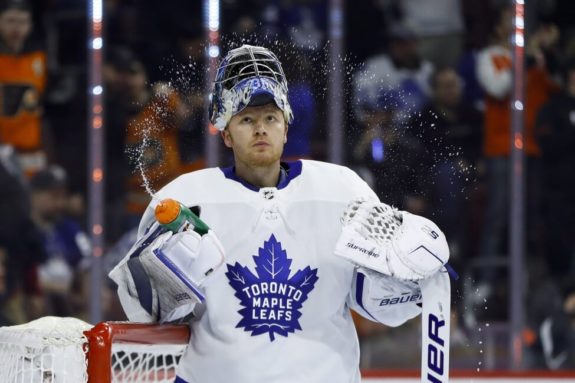
Here are some options that the Maple Leafs might have in net moving forward.
Keeping Andersen
The easiest and most obvious answer to plugging the Maple Leafs’ impending hole in net would be to simply extend Andersen. But when you dig into the underlying factors, that solution doesn’t seem so easy, or wise.
Andersen will be 32 years old going into the 2021-22 season, and while goalie performance is historically harder to predict than player performance, there is some research regarding goaltender age curves. What that research generally concludes is that goalies, on average, seem to peak in their early to mid-20s and decline after that.
Perhaps the most in-depth work comes from Steve Burtch of Pension Plan Puppets who looked at goaltender data from 1984 onward.
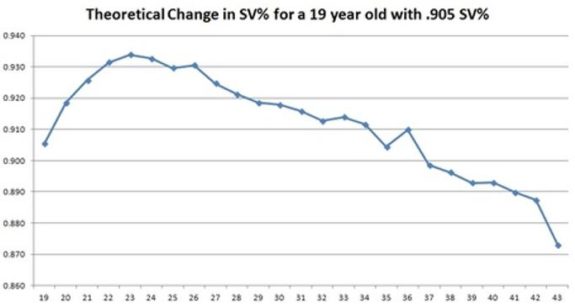
Burtch concluded that, “peak performance on average will occur at the age of 23, and roughly maintain until the age of 26. Beyond that a slow and steady drop off occurs for the average goalie.” He also adds, “This is hopefully enough to help people realize that generally speaking, goalies with longer careers do NOT continue to develop well past the age of 26. While some certainly do improve later, that is not the norm, and the average here would indicate most decline consistently beyond that age.”
I looked at the ages of Vezina Trophy winners over the last 10 seasons. The mean age comes out to 28.4, which is somewhat skewed by Pekka Rinne (35 years old) and Tim Thomas (36 years old). Removing them from the equation, the mean age of a Vezina Trophy winner is 26.6 – perfectly in line with Burtch’s findings.
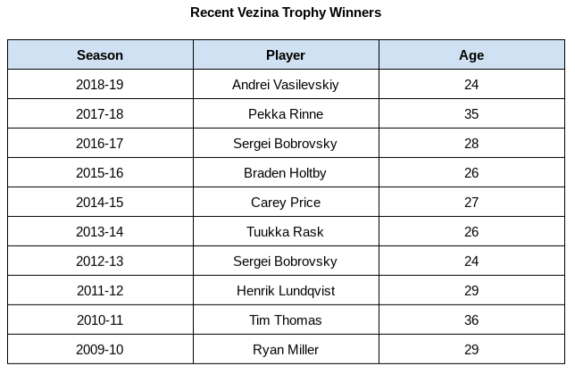
What does this mean for Andersen? Well, we’ve probably already seen his best hockey, and once his current contract expires, he’ll almost certainly be entering a noticeable decline. But with a salary cap that should increase and plenty of strong seasons behind him, it’s likely that Andersen will be seeking a raise over his current cap hit. Those two factors are obviously counter-intuitive: you don’t want to be paying a declining asset a sizable chunk of money. That’s why, ultimately, the Maple Leafs would be better served to move on from Andersen once his contract comes to an end.
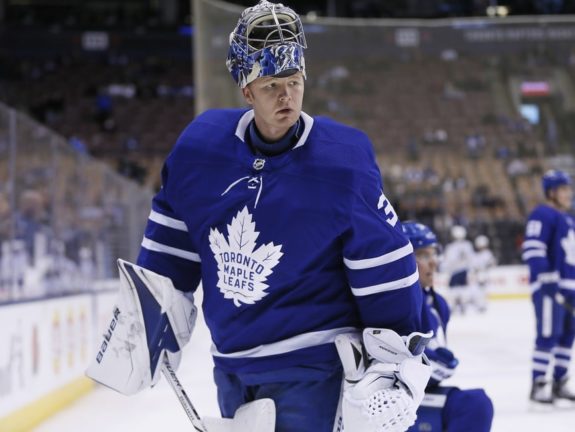
The one caveat would be if Andersen is open to a short-term deal with the team. Maybe the Maple Leafs win a Cup over the next two seasons, or Andersen feels that they’re on the cusp, and he wants to stick around at a discount. In that case, it may make sense to extend Andersen for around two years at a modest cap hit. The key benefit of such a deal would be to provide a buffer for the organization’s young goaltenders to keep developing.
That said, here’s a look at some of those young goaltenders who could take the reins from Andersen in the not-so-distant future.
Internal Promotions
Beyond Andersen, the Maple Leafs are really putting all their eggs into two baskets: Joseph Woll and Ian Scott.
Woll is a 21-year-old who just completed his senior year at Boston College, where he put up strong numbers considering the poor team in front of him. Boston finished with 23 points in 24 games, good for seventh out of 11 teams in Hockey East. Woll finished seventh among goaltenders with a goals-against average (GAA) of 2.17 (just 0.05 more than third-place Cayden Primeau), and he was tied for fourth in save percentage (SV%) at .926. After his college season came to a close in the spring, he moved to Toronto to work with the Maple Leafs staff.
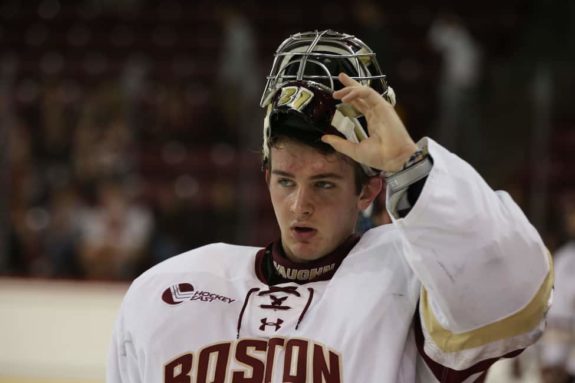
Scott is probably considered more of a wildcard than Woll. In 2017, the Maple Leafs decided to draft Scott in the fourth round despite a poor 3.69 GAA and .895 SV% with the Prince Albert Raiders of the WHL. His numbers weren’t helped by a terrible Prince Albert team that finished third-last in the league with 49 points. Clearly, though, the Maple Leafs saw enough talent in Scott to take a chance on him.
The Raiders improved significantly in 2017-18, jumping up to 77 points, but Scott did not see that same kind of progression. While his GAA fell by over half a goal to 3.10, his SV% remained nearly identical at .897. It was not until last season that Scott really exploded, posting a sterling 1.83 GAA and .932 SV% en route to a first-place finish and WHL Championship. Is Scott beginning to fulfill his potential or was the season a flash in the pan?

With only four professional goalies in the Maple Leafs organization right now (Andersen, Michael Hutchinson, Kasimir Kaskisuo, and Michal Neuvirth on a professional tryout), it’s still up in the air whether these young netminders will start in the AHL or the ECHL this coming season. Either way, we will get a much better idea of what these goalies are capable of, and what they might become, over the next season.
Woll and Scott are still very young and will likely require at least two years of seasoning in the minors before having a crack at the NHL roster. But if Andersen is allowed to walk, one of them very well may be the heir to the throne (or net) in Toronto.
Free Agency or Trade
If they’re seeking a long-term solution in goal, the Maple Leafs likely have better options than free agency. In 2021, the only notable unrestricted free agent goaltender below the age of 30 will be Jordan Binnington, who just led the St. Louis Blues to their first-ever Stanley Cup. Binnington will be 28 years of age at that point, and while that is statistically the end of his prime, he will likely be able to maintain at least an average level of performance into his early 30s. If Binnington does make it to free agency, the Maple Leafs could target the Stanley Cup-winning goaltender – provided their salary cap structure allows for it.

There are also a couple of cheaper stopgaps if they choose to go that route, with Petr Mrazek, Jake Allen, and Phillip Grubauer available that offseason. The plan here would probably be to ease one of Woll or Scott into an NHL role alongside a proven, cost-effective veteran.
The other option is, of course, acquiring a goaltender via trade, and the Maple Leafs are no strangers to pulling off blockbuster deals. This past January, general manager Kyle Dubas traded away prospects Carl Grundstrom and Sean Durzi plus a first-round pick to the Los Angeles Kings in exchange for defenceman Jake Muzzin. And in fact, Andersen himself was acquired from the Anaheim Ducks in exchange for a first and second-round pick back in 2016 by former GM Lou Lamoriello. So while such a trade may be impossible to predict, the possibility is certainly always out there. And for a team like the Maple Leafs that should be in win-now mode for at least the next five years, the price of a couple draft picks is secondary to the value of a strong starting goalie.
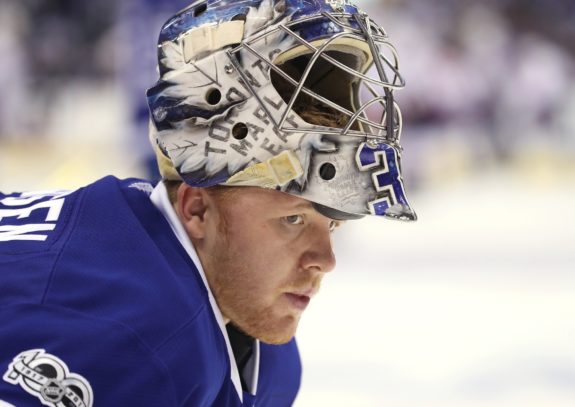
Regardless of how they decide to deal with this impending issue, the Maple Leafs should do everything in their power to make the best of what could be Andersen’s final two seasons in Toronto. They might not have another goaltender of this caliber for a long time.
Player stats from https://www.hockey-reference.com/ and http://www.hockeydb.com/C
Contract information from https://www.spotrac.com/